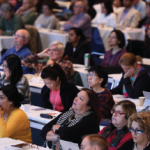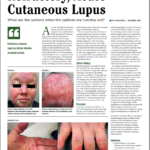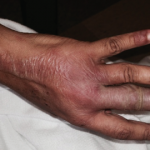(Reuters Health)—Nail salon drying lamps that emit ultraviolet (UV) light may contribute to periungual cutaneous lupus erythematosus lesions, according to case reports detailed in a recent publication.1
Exposure to the sun has long been linked to exacerbations of skin lupus, and, more recently, other types of light sources including surgical lamps have been connected to cutaneous lupus flares, said senior study author Victoria Werth, MD, of the Department of Dermatology at the Perelman School of Medicine at the University of Pennsylvania, Philadelphia and the Corporal Michael J. Crescenz Veterans Affairs Medical Center.
“The lamps used in salons to dry nails predominantly use UVA wavelengths,” Dr. Werth says by email. “UV A type 2 light UVA-2 is thought to be pathogenic in lupus.”
In a research letter published in Rheumatology, Dr. Werth and colleagues detail two case reports of patients who developed new periungual cutaneous lupus erythematosus (CLE) lesions after using nail salon drying lamps to help set gel manicures.1
One patient was a 35-year-old female of South Asian descent who had a history of systemic lupus erythematosus (SLE) and discoid lupus erythematosus (DLE) diagnosed about 12 years earlier. Interventions for this patient included 250 mg of chloroquine three times per week, 0.6 mg colchicine daily, 3,000 mg of mycophenolate mofetil daily, and clobetasol 0.05% ointment.
This patient had experienced lupus manifestations including thrombocytopenia, leukopenia, photosensitivity, arthritis, and oral ulcers. She also had positivity for several serologies including ANA, dsDNA, SSA and RNP.
The second patient was a 40-year-old female of African American descent with a history of SLE and DLE who had been diagnosed about four years prior. This patient received treatments including 400 mg of hydroxychloroquine daily, 100 mg of azathioprine daily, 6 mg of methylprednisolone daily, and topical steroids including pimecrolimus 1% cream, triamcinolone 0.1% ointment, and clobetasol 0.05% ointment.
In the second patient, lupus manifestations included lymphopenia, proteinuria, arthritis of the wrists, hands, and feet. This woman had positivity for serologies including high-titer ANA 1:2560, and dsDNA antibody.
These women both had been getting manicures roughly every one-to-two months for several years.
The first patient started noticing lesions on her hands after about six months of regular gel manicures and reported a possible cumulative effect.
In the second patient, new erythema on her hands appeared roughly one week after getting a gel manicure.
Even though RNP antibodies can cause periungual lesions, the researchers note that both patients’ hand lesions were significantly exacerbated by receiving gel manicures.
Neither patient received a biopsy or laboratory testing, due to the high clinical suspicion of CLE induced by the UV light exposure.
In both patients, CLE lesions resolved after several weeks, which was typical of when they had CLE lesions at other sites.
Reference
- Keyes E, Grinnell M, Vazquez T, et al. Ultraviolet light exposure from manicures in cutaneous lupus erythematosus (CLE). Rheumatology (Oxford). 2021 Sep 23;keab720. Online ahead of print.



